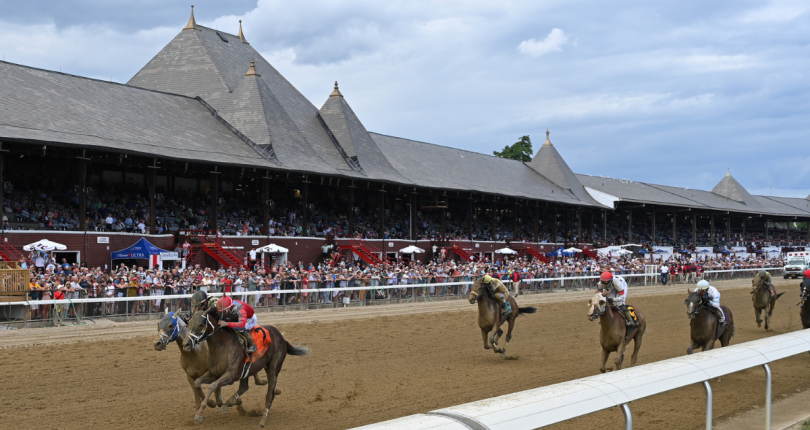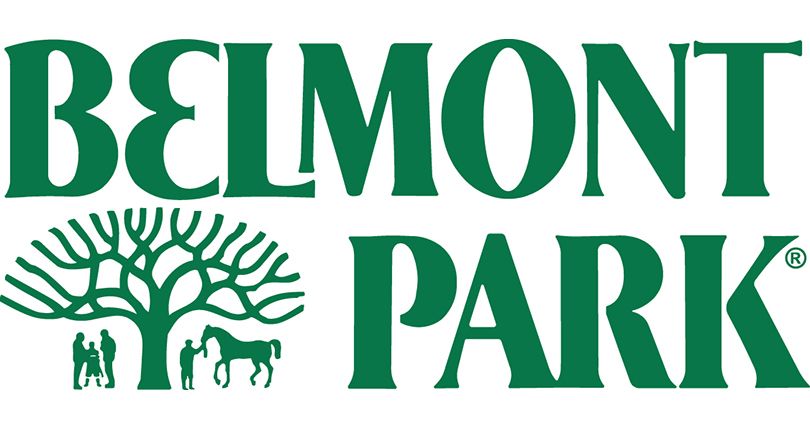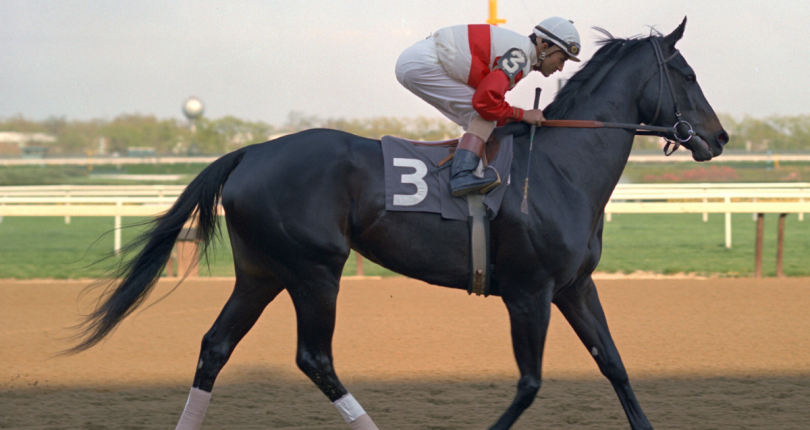
NYRA highlights safety initiatives and racing surface analysis as Belmont spring/summer meet begins
by NYRA Press Office
Live thoroughbred racing returned to Belmont Park on Friday, April 26 for its 48-day spring/summer meet, and the New York Racing Association, Inc. (NYRA) today highlighted its broad-based safety program currently in effect at all NYRA tracks.
In addition to accreditation of each NYRA track by the National Thoroughbred Racing Association Safety and Integrity Alliance (NTRA), a variety of initiatives have been put in place since 2013 at all three NYRA racetracks - Saratoga Race Course, Belmont Park and Aqueduct Racetrack - in areas such as racing surfaces and race-day scrutiny, as well as capital improvements and collaborative efforts with industry partners to ensure the safety of all participants.
These extensive reforms and commitment to improving the safety of NYRA's racing operations have led to demonstrably safer races. NYRA's fatality rate has remained below the industry average in each of the previous six years.
In 2018, NYRA's fatality rate was 1.20 per 1000 starts as reported by The Jockey Club's Equine Injury Database. In addition, at the recently concluded 2019 Aqueduct winter/spring meet (January 1-April 20), the fatality rate was 0.86 per 1000 starts. The 2018 national average as reported by The Jockey Club is 1.68 per 1000 starts.
Racing Surfaces at NYRA
NYRA conducts extensive and continuous testing of racing and training surfaces before, during and after each race meet. NYRA has pioneered the use of a system that utilizes both daily measurements and enhanced data collection to create and maintain safe and consistent track surfaces.
Before any meet, the Racing Surfaces Testing Laboratory (RSTL) team performs comprehensive sampling and analysis of the following:
• Laboratory testing of the track material;
• Inspection of the base and cushion using ground-penetrating radar;
• And inspection of the overall performance and consistency of the surface using the Biomechanical Surface Tester, which replicates loads and speed of a thoroughbred's leading forelimb at gallop.
Before and after each day of racing, NYRA performs testing and data collection of cushion depth, moisture content, and surface consistency to ensure the readings are within pre-determined safety criteria.
NYRA consults and actively shares internal data and daily measurements with leading independent testing and engineering firms to provide additional levels of scrutiny and relevant expertise. All track maintenance work is meticulously documented, logged and subsequently shared in real time both internally and with outside consultants.
All track maintenance decisions and actions are informed directly by scientific data matched with current and forecast weather conditions.
NYRA has consistently shown a commitment to implement science-driven best practices to establish and maintain safe surfaces and facilities for its equine and human athletes. To meet this goal, NYRA has made significant capital investments in recent years to upgrade and modernize racing and training facilities.
Since 2013, NYRA has upgraded turf courses at Belmont, Saratoga and Aqueduct with modernized irrigation and drainage systems to improve the overall surface by increasing turf growth, recovery and consistency. Turf courses at Belmont and Saratoga were widened to create additional running lanes and reduce wear. During the same period, NYRA has renovated and widened the Belmont Training Track and Oklahoma Training Track turf course at Saratoga to add running lanes, decrease congestion and improve overall safety.
Additionally, all three tracks and both training tracks feature innovative alarm systems designed to quickly alert personnel of a loose horse.
In 2017, NYRA completely renovated the main track at Aqueduct while at the same time replacing the inner dirt track with a second turf course and adding the latest in safety rail technology. The opening of the 2018 fall meet at Aqueduct featured the debut of a new surface on the inner turf course. As a result, all Aqueduct racing surfaces have been replaced or completely renovated since 2017.
Through this commitment to track safety and science, NYRA has earned and maintained accreditation for all three racetracks by the National Thoroughbred Racing Association Safety & Integrity Alliance, which, under the direction of NYRA Vice President of Racing Surfaces and Facilities Glen Kozak, have earned "best practice" ratings in virtually every area examined by the Alliance.
Race Day Scrutiny
Race day inspections are performed by four NYRA Veterinarians and overseen by Dr. Anthony Verderosa, NYRA's Veterinary Department Director, to regulate the safety and welfare of all thoroughbred racehorses at each NYRA track.
Pre-race Horse Inspection: A NYRA Regulatory Veterinarian personally inspects each horse entered to race on the morning of the race date to ensure that the horse - in their professional opinion - is fit to compete.
This inspection shall include: a review of previous pre-race inspection findings for the horse; physical inspection of the horse in the stall to include palpation of both front limbs and any apparently abnormal structures observed in the hind limbs; observation of the horse outside the stall while being walked and jogged in hand away from and toward the examining veterinarian; discussion with the trainer or their designee regarding changes in physical findings or layoffs.
Pre-race Horse Observation: NYRA Regulatory Veterinarians continuously observe the horses at each stage of the pre-race process. This observation begins with the walk over from the barn area, includes each stage of the saddling process, post parade, warm up and transitions only when all horses are in the starting gate ready to race.
NYRA Regulatory Veterinarians have the authority to recommend a scratch to the Stewards at any time prior to the running of the race.
Observation of horses during and after the race: NYRA Regulatory Veterinarians observe all horses during the race and after the race, including the unsaddling process and walk back to the barn area.
All information and data generated by the pre-race examination and race day observation is catalogued and recorded by NYRA Regulatory Veterinarians to add medical details to past performances and workout information.
Enhanced Levels of Scrutiny
In 2013, to ensure the safety of horses placed on the steward's and/or veterinarian's list, as well as those that have not started within a set timeframe, NYRA implemented enhanced levels of scrutiny to monitor such horses.
Steward's List: The stewards may place the name of any horse on the steward's list for any reason they may deem to be proper. While on this list, the horse may not race or be entered to race. The most common reason for placement on the steward's list is poor performance, which is defined as having been beaten by at least 25 lengths in its last race.
Veterinarian's List: The veterinarian's list is designed as a safeguard to prevent unsound or unhealthy horses from being entered before the horse has recovered from a physical condition or illness. Usually these horses have been identified during pre-race inspections as being unsound or having been observed either on-track or in the post-race test barn as unsound or experiencing epistaxis (bleeding from one or both nostrils).
To be removed from the veterinarian's list, the horse must pass a pre-workout soundness inspection, record a 4-furlong workout in 52 seconds or less before a NYRA Regulatory Veterinarian, and pass a post-workout inspection and blood test for the presence of medication above allowable thresholds.
A horse is ineligible to compete if on the steward's list or veterinarian's list.
Workout Scrutiny
First time starter: A first-time starter must have at least three works in the previous 45 days, one of which must have been at least 1/2 mile; and been gate approved by the starter.
Not started within 90 days: The horse must have at least three works within 90 days of the proposed start date, two of which must have been within the last 60 days and one of which must have been at least 1/2 mile; and one work at least 3/8 mile or further within 30 days of the proposed start.
Not started within 60 days: The horse must have at least two workouts within 60 days of the proposed start date, one of which must have been at least 1/2 mile; and one work at least 3/8 mile or further within 30 days of the proposed start.
Not started within 30 days: A horse must have one workout of at least 3/8 mile or further within 30 days of the proposed start.
Collaborative Efforts With Industry Partners
NYRA shares its commitment and focus on safety with the New York Thoroughbred Horsemen's Association (NYTHA) and the New York State Gaming Commission (NYSGC), with the input of industry partners including the NTRA.
The collective efforts of NYRA, NYTHA and the NYSGC set a standard of excellence when it comes to the evolution and science of preventing and investigating the root causes of equine injuries.
NYRA has implemented or enhanced the following policies and procedures since 2013 in conjunction with NYTHA and the NYSGC to further increase the safety of its racing operations:
• Formation of the Equine Safety Review Board, a group comprised of NYRA veterinarians, track management and the New York State Equine Medical Director, which investigates any race day equine catastrophic injury.
• Creation of the Equine Safety Committee of the NYRA Board of Directors tasked with focusing on continuous analysis and further advancement of NYRA's overall safety program.
• Creation a special section of NYRA Security called the Horse Watch Detail, who receive additional training and have developed expertise in how to properly recognize and monitor the activities of third parties in NYRA barn areas.
• Formation of a Strategic Plan to Reduce Racehorse Fatalities in the Mid-Atlantic. As members of a group led by the Thoroughbred Horsemen's Association (THA); Dr. Scott Palmer, Equine Medical Director of the New York State Gaming Commission (NYSGC), and Joe Appelbaum, President of the New York Thoroughbred Horsemen's Association (NYTHA); and respected veterinarians Dr. Kathleen Anderson and Dr. Reynolds Cowles, both former presidents of the American Association of Equine Practitioners, NYRA participated in the development of the Strategic Plan adopted in the Mid-Atlantic Region to incorporate regional safety best practices and improved methods to identify horses at increased risk of injury, the implementation of protective factors to reduce the risk of injury, and the improvement of the general health of the horse.
Live racing returns to Belmont Park on Thursday with a nine-race card and 1:30 p.m. first post time.





 Gambling Problems? The New York Racing Association encourages responsible wagering. If gambling is a problem for you or someone you care about, help is available 24 hours a day. Scan here to talk with someone now about your gambling. Or call toll-free 1-877-8-HOPE-NY.
Gambling Problems? The New York Racing Association encourages responsible wagering. If gambling is a problem for you or someone you care about, help is available 24 hours a day. Scan here to talk with someone now about your gambling. Or call toll-free 1-877-8-HOPE-NY.